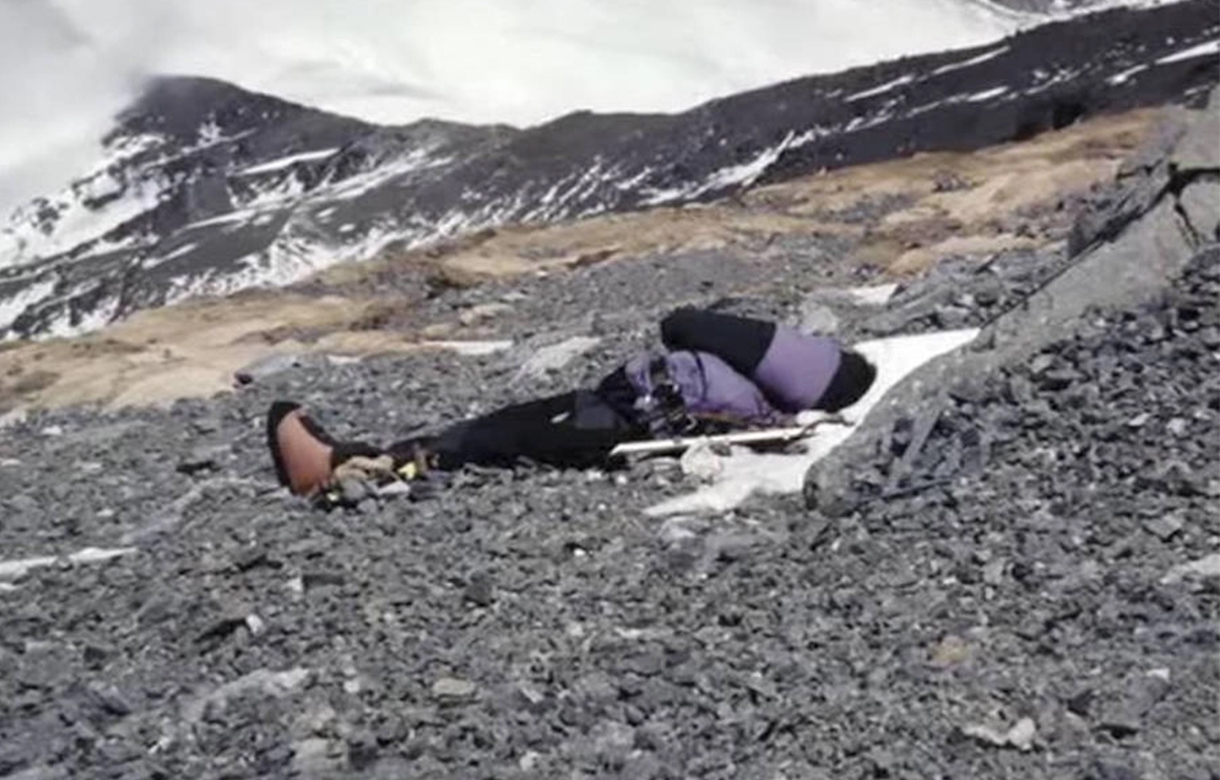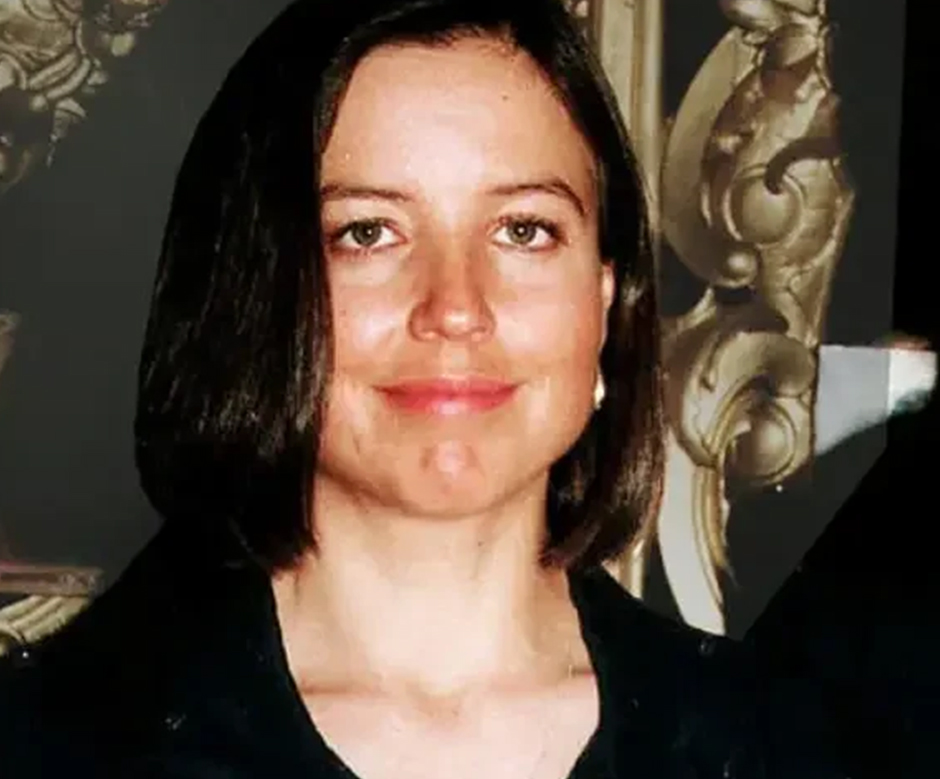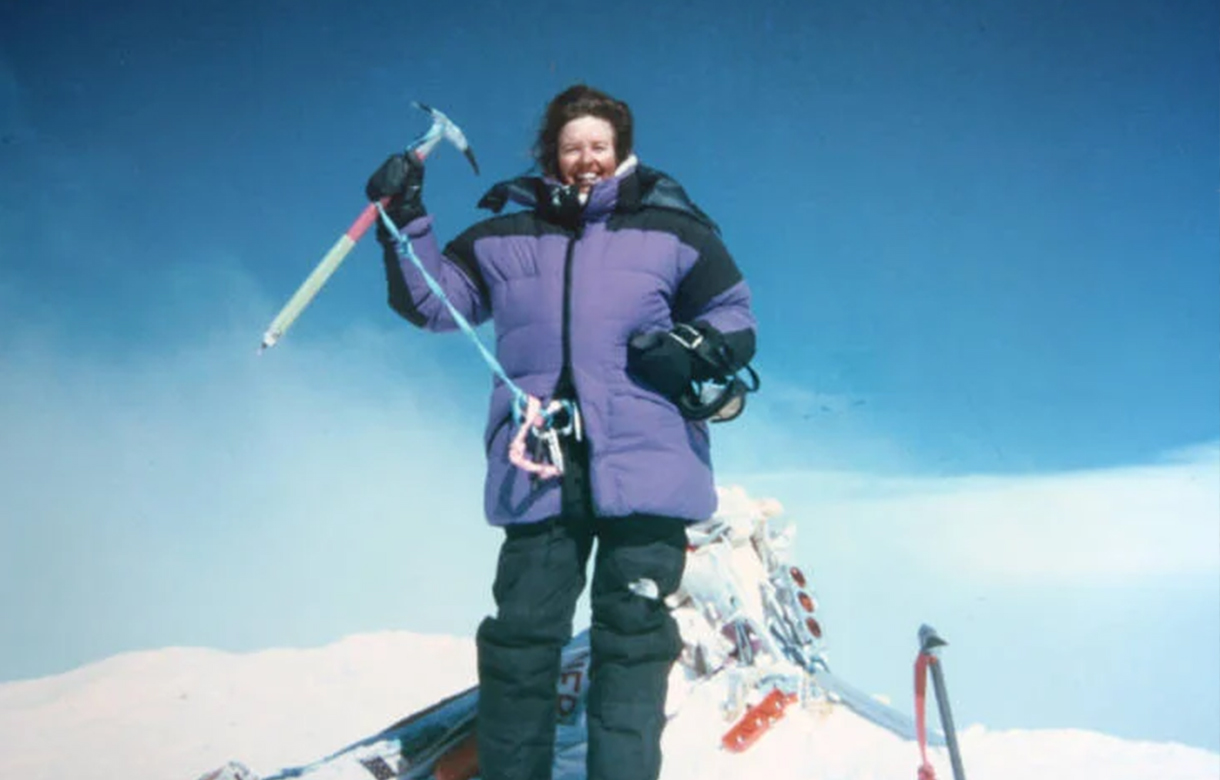Mount Everest the tallest peak in the world at an elevation of 8,848 meters (29,031 feet) has always stood as the ultimate test of human endurance. On its slope, ambition meets the risks of high-altitude mountaineering. Every year climbers from all around the globe gather at its basin driven by the dream of standing on the top of the world.
But, behind the glory and the record-breaking headlines lies a much darker and reality that is often overlooked, Mount Everest is also referred to as ‘the world’s highest graveyard’. More than 340 climbers have lost their lives attempting to scale this sky-touching peak. Many of those bodies remain along the climbing route and are frozen in time.
Among many Everest dead bodies, one name that continues to echo through the mountaineering community and beyond is the ‘Francys Arsentiev- Everest Sleeping Beauty’. In 1998 she set out to make a record in the mountaineering world as the first-ever American woman to scale the highest peak of them all without using supplementary oxygen.
What followed, however, was not a story of triumph but a tragedy that became one of the most heartbreaking and tragic events in Everest’s modern history. The story of Francys Arsentiev is not just about a fatal climb. It is about the love, sacrifice, human limits and the haunting beauty of dreams pursued to the edge of death.
Who Was Francys Arsentiev- Everest Sleeping Beauty?
Francys Arsentiev who is often referred to as the ‘Mount Everest Sleeping Beauty’ was an American mountaineer. Her tragic death is forever tied to one of the most haunting history of high-altitude mountaineering. Francys-arsentiev was born on 18th January 1958 in Honolulu, Hawaii.
She earned her undergraduate degree in business from the University of Louisville. Arsentiev later received her master’s degree from the International School of Business Management in Phoenix. Francys Arsentiev worked as an accountant in the ski town of Telluride, Colorado in the 1980s.
That’s where she met legendary Russian climber Sergei Arsentiev. The pair it off and tied the knot in 1992. Francys Arsentiev husband was already a renowned climber in Russia and was nicknamed the ‘Snow Leopard’ by his countrymen.
Francys had never been a serious climber before she met her husband. However, feeding on Sergei’s encouragement, she started exploring her passion for mountaineering. As a result, she gradually soaked in the niche and started pushing her limit on higher and higher mountains with her husband.
The couple climbed many Russian peaks together. Francys Arsentiev also made history as the first-ever US woman to ski down Elbrus which is a major peak in the Caucasus Mountains. She also summitted the east and west peaks of Elbrus.
Francys and her husband used the Denali expedition as a proving ground and formulated a plan to make the name ‘Francys Arsentiev’ immortal in the mountaineering world. Francys was dreamed of being the first US woman to summit Everest without using supplemental oxygen.
But, how her daring dream unfolded as one of the most tragic and haunting events in the mountaineering world as she earned the name ‘Everest Sleeping Beauty’. This nickname does not just stem from her death on the mountain but from the bone-chilling image of her final resting place.

The Tragic 1998 Everest Expedition: Francys Arsentiev’s Final Climb
Francys Arsentiev and her husband embarked on one of the most ambitious and dangerous challenges in modern mountaineering in May 1998. The couple ascended from the Advance Base Camp to North Col on 17th May. On the following day, the mountaineering duo had reached 7,700 meters (25,262 feet).
At the time, 21 climbers had reached the summit of Everest on the North (Tibetan Side). The couple reached Camp 6 (8,203m/ 26,193ft) on 19th May. By this part of scaling, the mountaineering duo reported by radio that they were in ideal shape to push further and were going to start their summit scaling on 20th May at 1:00 A.M.
They proceeded with their pre-determined schedule for the push. However, due to failed headlamps near the First Step, they had to turn back on 20th May. Francys Arsentiev and her husband tried the summit push again on 21st May. But, only covered 50 to 100 meters of ground before turning back.
After aborting two attempts for the summit push, the couple began their final ascent on 22nd May. By this point, they had spent more than 72 hours in the ‘Everest Death Zone’. If you are not familiar with the Everest death zone, it is a segment above 8,000 meters (26,246 feet) where oxygen is dangerously low.
At this elevation, even climbers with supplementary oxygen are at greater risk of Altitude Mountain Sickness (AMS), High Altitude Pulmonary Edema (HAPE) and High Altitude Cerebral Edema (HACE). This is the section where the body slowly begins to die with every moment even at rest, cell by cell.
As they had spent a significant amount of time in the death zone the pair were not full of energy like their initial summit push on 20th May. Francys Arsentiev husband who was a professional mountaineer was also not in good shape by this point.
How Did Sleeping Beauty Die on Mount Everest? Final Moments: Francys' Death on Everest
Francys Arsentiev and her husband did manage to reach the summit of Everest on 22nd May. However, due to the absence of an oxygen bottle inside the death zone, they moved slowly toward the peak. They completed the summit of Everest dangerously late in the day.
There is 2 o clock rule Mount Everest; climbers are strongly advised to reach the summit of peak by 2:00 P.M. If they haven’t reached the summit by 2 o’ clock, they are urged to turn back regardless of how close they are to the summit.
Most accidents on Everest occur during the descent, not ascent. Climbers have to consider several risk factors like darkness, bad weather and exhaustion during the returning part. That’s why it is extremely dangerous to keep scaling for the summit after 2 P.M. hence the 2 o clock rule Mount Everest.
Many climbers rely on supplementary oxygen for the climb. Running out of oxygen due to prolonged climb increases the risk of HAPE, HACE, exhaustion, or hypoxia. As Francys Arsentiev and her husband had made the summit push critically late, they were forced to spend one more night in the Everest death zone.
During the evening, the two were separated. Francys Arsentiev husband managed to make his way down to camp on the following morning. When he arrived, Sergei found out that his wife was not there. Realizing his wife had to be somewhere dangerously high on the mountain, Sergei Arsentiev set off to find her carrying medicine and oxygen.
On the morning of 23rd May, Francys Arsentiev was found by the Uzbek team that was pushing for the final few hundred meters to the summit. When the Uzbek team found her, Francys was half-conscious and was severely affected by frostbite and oxygen deprivation.
The Uzbek team found her hands and face affected by severe frostbite. She was unable to speak coherently and kept slipping in and out of consciousness. The climbing team tried to administer supplemental oxygen, massaged her limbs to restore circulation and dragged her downhill.
However, the Uzbek team after hours of effort and depleting their oxygen inside Everest death zone were forced to leave her behind to save their own life. Francys Arsentiev was still alive at this point. As the Uzbek climbers made their way to camp that evening, they saw Sergei Arsentiev on his way back to her. This was the last time the Russian climber was seen alive.
The next morning, 24th May, Cathay O’Dowd, British mountaineer Ian Woodall and several Uzbek expedition members encounter Francys while pushing for the summit. She was lying where she had been left on the evening before. Sergei Arsentievs’ axe and ropes were found nearby but he himself wasn’t anywhere close.
Both Woodall and O’Dowd called off their summit push in an attempt to save her. But, because of her immovable conditions, harsh weather and perilous location cyanide the death zone, they too were forced to abandon the rescue and descent to camp.
Francys Arsentiev died where they left her and as they found her, lying on her side, still clipped to the climbing rope. She took her last on the slope of Everest at the age of 40, and her corpse earned the nickname ‘ Mount Everest Sleeping Beauty’.
On Everest, moral decisions often collide with biological limits. It is not possible for even the strongest climbers to carry or rescue another person at that altitude. Francys Arsentiev henceforth dubbed as ‘Everest Sleeping Beauty’ became a tragical example of this brutal truth.

The Face Frozen in Time: Sleeping Beauty on Everest
For many years after her passing, Francys Arsentiev dead body remained on the mountain. It was a grim monument that represented the dangers of high-altitude climbing. Her body remained on the north face of Mt. Everest, preserved by extreme cold in a hauntingly lifelike state.
She lay on her side clad in her purple and black summit jacket still clipped to the climbing rope. This tragic image was seared into the memories of every climber who passed her. Hence, she came to be known as the ‘Sleeping Beauty of Everest’. Unlike many fallen climbers whose remains lie on the slopes anonymously, the sleeping beauty Everest body was instantly recognizable.
Climbers who passed her during their expedition saw Francys Everest sleeping beauty as the symbol of ambition and a silent warning to those who followed. As for some, it looked like a resting face after a long and tiring journey.
Mount Everest is often referred to as the world’s highest graveyard. There are dead bodies of more than 340 climbers on its mountain slopes. Most of the Everest dead bodies are never recovered because of the perilous logistics that are required for bringing bodies down from the death zone.
Francys Arsentiev the Sleeping Beauty of Everest one of the most visible Everest dead bodies and her body became an unintentional landmark to the climbers. For the next nine years after her death, she became an object of hundreds of photographs that showcased her mysterious resting profile. Francys Arsentiev son had to live through the nightmare of seeing pictures of his helpless mother’s dead face all over the internet.
Her body remained frozen directly on the main route of the summit. A ghostly figure and a reminder of how unforgiving the mountain can be to the climber heading toward the summit. For nearly a decade, Everest sleeping beauty laid peacefully on the mountain slope, unmoved, unnamed to many, but unforgettable to everyone.
Is Sleeping Beauty Still on Everest?
For nine years sleeping beauty Everest body remained on the mountain’s slopes. Her body became one of Everest’s most well-known markers. It was such an impactful marker that the expedition leader and climber would prepare in advance for the moment they would encounter her.
Some described the feeling of deep sorrow while others spoke of shame or guilt, the helplessness in the face of the tragedy that could never be reversed. There was a long-standing debate within the mountaineering community about whether to remove sleeping beauty Everest body or let it remain on the slopes.
On one hand, her body was a sobering reminder of the mountain’s merciless nature and aligned with the idea of ‘resting where you fall’ in the mountaineering community. On the other, her identity and humanity demanded more than to be left exposed on the slope for eternity.
Her, husband Sergei Arsentiev body was later discovered on the lower mountain by Jake Norton, an American mountaineer who was part of a 1999 expedition crew. The evidence suggested that the Russian climber fell down from the mountain slope while trying to rescue his trapped wife.
In 2007, British mountaineer Ian Woodland who had tried to rescue the sleeping beauty of Everest when she was taking her last breath on the mountain slopes organized an expedition to remove her body from the main trail.
This expedition was known as the ‘Tao of Everest’ and the team succeeded in removing the body from the main trail. As a closure, the expedition team wrapped her body in an American flag and lowered it down the mountain.
Today, the exact location of Mount Everest sleeping beauty is disclosed as a decision made out of respect for her and her family. This burial gave her a proper closure on the slopes that claimed her life. Francys Arsentiev sleeping beauty finally out of sight from the main route, rests forever peacefully amidst the clouds.

Legacy of Francys Arsentiev
The story of ‘Francys Arsentiev- Everest Sleeping Beauty’ is more than just a chilling mountaineering tragedy. It is a tale of ambition, devotion and the fine line between dreams and danger. Her legacy lives on not just as the first American woman to reach the peak of the tallest peak in the world without supplemental oxygen but also as the symbol of the cost such dreams carry.
Francys Arsentiev was not a professional climber by birth nor did she chase the thrill of scaling sky-touching peaks. She discovered mountaineering later in her life, inspired and encouraged by her mountaineering legend husband Sergei Arsentiev.
Then, she transformed herself into a force on the mountain and started making history. Her bold attempt to make the record on Mount Everest was not driven by fame or fortune but by a deep desire to push her own boundaries. In many ways, Francys was an ordinary woman who dared to do something extraordinary.
That is why the Everest sleeping beauty's legacy is both inspiring and heartbreaking. The death of the sleeping beauty of Everest exposed the stark realities of the expedition. On the treacherous mountain slopes, climbers learn that sometimes even love, preparation and determination are not enough.
However, despite all of that, perhaps the most enduring part of Francys Arsentiev’s legacy is not the tragedy itself, but the humanity that surrounded it. Her husband's final act of love where he didn’t care about his life, the group of climbers who tried to save her and later move her eternal resting place, global outpouring of empathy, a legacy etched in human compassion and not just sorrow.
Francys Arsentiev sleeping beauty may have perished on Everest but her name and story live on, in the hearts of those who read about her, speak her name and reflect on what it truly means to chase a dream on the unforgiving slopes of the world’s highest mountain.

